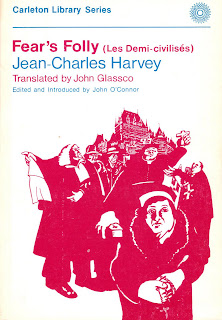
The Dead Seagull
George Barker
New York: Farrar, Straus & Young, [1950]
 Not a Canadian novel, but worthy of mention in this narrowly focused blog as a sort of companion to By Grand Central Station I Sat Down and Wept, Elizabeth Smart's account of her tortuous relationship with English poet Barker.
Not a Canadian novel, but worthy of mention in this narrowly focused blog as a sort of companion to By Grand Central Station I Sat Down and Wept, Elizabeth Smart's account of her tortuous relationship with English poet Barker.
Consider this his side of the story.
The nameless narrator, a poet protagonist, looks back on his brief marriage to Theresa. Theirs was a steady, staid, serene relationship, one rocked by 'the other woman'. 'Marsden Forsden stepped out of a Venetian ceiling and into our hospitality', the narrator tells us. The entrance is no accident. Like Smart, her model, Marsden has fallen in love with a poet through his verse, and has attended dozens parties in hopes of meeting him. Eventually, Marsden contacts Theresa, conveniently an old school friend. Barker's hero is easily seduced. Moments before their first kiss, she tells the man who is to become her lover, 'It was your book. When I read it I sat down and wrote one exactly like it.'
Catch that?
'...I sat down and wrote...'
Not wept.
Barker's second and last novel, its plot may be trite, but the use of language and arrant displays of obsession, loathing and vainglory make for a rewarding, if disturbing, read.
Cassandra Pybus wrote about The Dead Seagull as her contribution to Lost Classics (a personal fave). She recalls coming upon the novel in a pile of bargain books and being 'astounded to read that Barker was describing the exact same passionate travail as Smart.' She adds: 'I have never heard another [sic] thing about this book.' No doubt. By Grand Central Station has acquired iconic status – and has been drawn upon repeatedly by Steven Patrick Morrissey* – while Barker's book is more than forty years out of print.
Trivia: Barker and Smart shared the stage reading from The Dead Seagull and By Grand Central Station I Sat Down and Wept at a 1980 Glasgow writers' conference. Imagine the discomfort.
A Bonus: The working title was Of Love.
Object: A handsome hardcover with dustjacket designed by Humphrey Spender. The religious tone set by the allusion to St Sebastian continues on the flap copy: 'It is a tragedy, told more as it might be poured out in the confessional of the Roman Catholic Church than in the more traditional modes of the English novel. Its subject is love; but it is also original sin, in the sense that Cardinal Newman wrote "We are all implicated in some dreadful aboriginal calamity". The theme of The Dead Seagull is that this calamity is love itself.' Note that Spender's arrow touches the right pectoralis major (opposite the heart), but does not pierce the skin.
Access: Universities and the ever reliable Toronto Public Library. I've spotted a paperback edition once or twice in our used bookstores, though no online Canadian bookseller offers the book. Very good copies of the true first, published by John Lehmann, can be had for as little as US$25. While the American first is currently listed online at US$20 to US$75, I bought my copy a couple of weeks ago at a Manhattan bookstore for US$15.
* See 'Reel Around the Fountain', 'Shakespeare's Sister', 'The Headmaster Ritual', 'Well I Wonder', 'What She Said', 'London', 'Late Night, Maudlin Street', 'Billy Budd, 'Do Your Best and Don't Worry', et cetera, et cetera, et cetera, et cetera...

















